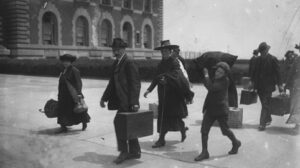
Credit: Library of Congress Prints and Photographs Division, George Grantham Bain Collection, 1907
Italian immigration to the U.S. reached its peak of over two million between 1910 and 1920. Immigration quotas passed in the 1920s tended to favor earlier generations of immigrants by giving preference to Northern Europeans.
Discriminatory immigration policies aimed at southern and eastern Europeans figured into the quota-based policies of the 1920s. With the passage of the Immigration Act of 1924, also known as the National Origins Act or Johnson-Reed Act, the U.S. used restrictive immigration policies in the 1920s based on the 1890 proportions of foreign-born European nationalities. Since the 1890 census reflected higher numbers of northern Europeans, immigrants from those countries had greater opportunities to emigrate. The arguments, outlined in Madison Grant’s 1916 book The Passing of a Great Race, held that older immigrants were skilled, thrifty, hardworking like native born Americans and recent immigrants from southern and eastern Europe were unskilled, ignorant, predominantly Catholic or Jewish and not easily assimilated into American culture. Madison Grant and Charles Davenport, among other eugenicists, were called in as expert advisers on the threat of “inferior stock” from eastern and southern Europe, playing a critical role as Congress debated the Immigration Act of 1924. The act attempted to control tl number of “unfit” individuals entering the country by lowering the number of immigrants allowed in to fifteen percent of what it had been previously. Existing laws prohibiting race mixing were strengthened as well. The adoption of incest laws and many anti-miscegenation laws were also influenced by the premises of eugenics.
The Naturalization Act of 1906 provided the conditions under which immigrants to the U.S. could become naturalized citizens. Under the act, only white persons and persons of African descent or African nativity were eligible. In 1922, a Japanese businessman named Takao Ozawa filed for U.S. citizenship under the act; he did not challenge the constitutionality of the racial restrictions, but argued that people of Japanese descent should be classified as white. Associate Justice George Sutherland however, ruled that only Caucasians were white, and therefore the Japanese could not be considered white but rather were of an “unassimilable race,” not covered by any Naturalization Act. Sutherland issued a similar ruling three months later in another Supreme Court case. This one, known as United States v. Bhagat Singh Thind, concerned another alien seeking U.S. citizenship. The decision classified South Asian Indians as Asian for the first time, and not only affected immigrants seeking naturalization, but allowed previously naturalized Asian Indians to be stripped of their American citizenship, since it could be claimed that they had gained citizenship illegally a claim often upheld. Once they had been stripped of their citizenship, Indian land owners became subject to the California Alien Land Law and similar laws against Asian immigrants. With the Asiatic Barred Zone Act of 1917 preventing new immigration to the U.S. to strengthen the Indian community, most Asian Indians left the U.S., sO that by 1940 their population was reduced by half to 2,405.
- Congress passed the Asiatic Barred Zone Act, also known as the Immigration Act of 1917, overriding President Woodrow Wilson’s veto. The legislation essentially prevented immigration from British India to the U.S., although loopholes exempted whites from the region from being denied admission to the
U.S. - Congress gave Native Americans the right to vote in 1924.
- Virginia’s Racial Integrity Act of 1924 codified the “one-drop rule” as the standard racial classification for people of mixed ancestry. A person with even “one drop” of non-white ancestry was classified as “colored” or non-white.

Copyright David Bhagat Thind, www.bhagatsinghthind.com All rights reserved.
.the average man knows perfectly well that there are unmistakable and profound differences…”
– Supreme Court Justice George Sutherland in United States v.
Bhagat Singh Thind
In the case of United States v. Bhagat Singh Thind, Associate Justice George Sutherland interpreted the law based on his opinion that the framers of the Constitution would never have intended to allow Bhagat Singh Thind (pictured above) to become a naturalized citizen, in spite of the fact that Indians were indeed anthropologically Caucasian. Sutherland commented that “the average man knows perfectly well that there are unmistakable and profound differences,” clearly implying that ‘Caucasian’ meant ‘white’. Sutherland chose not to create a new classification, but instead found Indians to be Asian, which made them subject to pre-existing anti-Asian laws passed nationally and in California, due to the influence of the Asiatic Exclusion League. In a final twist to the story, a few years later Thind applied for and received citizenship through the state of New York not long after his original U.S. citizenship was revoked.




